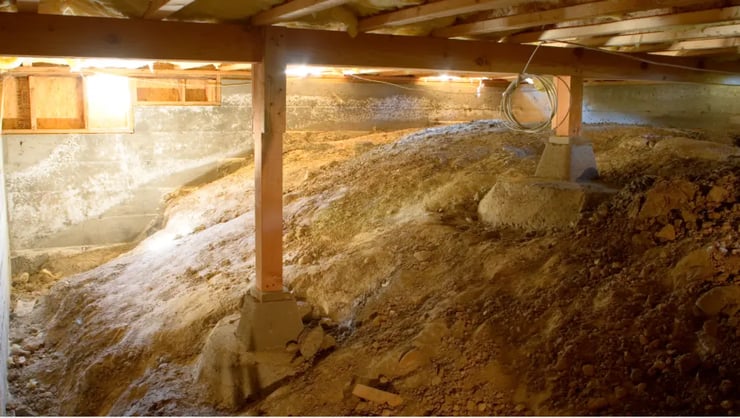
Even with a couple of months of the newest Risk Rating 2.0 update with the National Flood Insurance Program (NFIP) at our very lives, a lot of homeowners still find some challenges in understanding its newest rating system.

One of the biggest changes that came with the rating structure of federal flood insurance is the flood risk variables and one of the most complex ones is just below your feet. Today, we want to talk about what is first-floor height? How does this impact your flood insurance premiums? How can you mitigate this flood risk variable for your NFIP policy?
House Elevations on Risk Rating 2.0
The Risk Rating 2.0 presents a bunch of new things to analyze the flood risk on a building. Since we're talking about flood then one of the biggest concerns is the base flood elevations and how it interacts with your insured building.
This new rating system in the National Flood Insurance Program (NFIP) had to address the elevation of homes across the country. As the height of floodwater increases, it's equally important to Federal Emergency Management Agency and the NFIP that flood mitigation is being done to properties to avoid substantial and life-threatening damages. Enter the separation between distance to the ground and first-floor height.
Let's paint a picture for example, in the video below you will see that the house behind me sits directly on the ground or what we'd call a "slab on grade" type of foundation. This is an easy example because there's basically no difference between the lowest ground level of the building at its first level of the habitable floor.
On the other hand, if you have a basement and it's habitable meaning a person can basically live, breathe, dine, and sleep in it, then you might have a different rate compared to houses like a slab on grade. This sets apart the two rating factors. When it comes to first-floor height (FFH) basement-type foundations can be a major player in increasing your flood insurance rates with FEMA and the NFIP.
The new National Flood Insurance Program (NFIP) rating tool indicates that your flood insurance policy with Risk Rating 2.0 will rate you depending on the relative distance of the ground, in which base flood elevations are calculated, as well as where your first-floor height sits.

Think of it this way, in the legacy program or the NFIP 1.0, crawlspaces have a huge impact on rates depending on whether or not it has flood vents whereas NFIP 2.0 basements, that aren't used for storage or access, can negatively impact you if a surveyor from the Federal Emergency Management Agency (FEMA) was able to detect that your basement is livable.
This way, properties like these will have their first-floor height and distance to ground in negative numbers which generally means more expensive flood insurance premiums. It's important to understand this rating factor under the FFH since this is one of the things that are the hardest to arrange or mitigate.
Risk Rating 2.0 — Shift on Premium Rates
As we said before, the NFIP and FEMA's approach on flood insurance with the new Risk Rating 2.0 program is to have a more accurate and precise representation of your flood risks in order to get your flood insurance rate.
This means that we will no longer be using flood maps and flood zones as a rating measurement, but rather a regulatory factor on flood insurance especially for properties in the special flood hazard areas (SFHA) or high-risk zones which face a significantly higher chance and more devastating impacts of flooding.
As a refresher, we wanted to include the flood risks variables that measure your flood risk score with FEMA and the NFIP. These variables that determine your rate are as follows:
- Foundation Type (e.g. slab on grade, crawlspace, basement)
- Distance to the ground
- First-floor height
- Distance to a water source (e.g. creek, river, lake)
- Flood type (e.g. pluvial, fluvial, or coastal)
- Flood frequency
- Rebuilding or replacement cost
- Flood risk mitigation measures on the property
- Flood claim variable

Despite having a new form of rating, some things never change with the federal flood insurance. One of the things that are staying the same is coverage amounts with the NFIP. This means that you're still going to have to deal with that $250,000 max on building coverage and $100,000 max for contents coverage.
Wait periods are also staying the same with the 30-day rule with the Federal Emergency Management Agency (FEMA) to get your flood insurance policy to take effect after purchase.
If you have any questions on how NFIP Risk Rating 2.0 measures your flood risk score and rate you, how first-floor height works, and/or anything about floods and insurance, click below to reach us or visit our Flood Learning Center where we try to answer your flood insurance questions.
Remember, we have an educational background in flood mitigation which lets us help you understand your flood risk and mitigate your property long-term.
-rgb-300px-w-300ppi.png?width=350&height=124&name=tfig-logo-inverted-(for-dark-backgrounds)-rgb-300px-w-300ppi.png)
-rgb-300px-w-300ppi.png?width=301&height=107&name=tfig-logo-inverted-(for-dark-backgrounds)-rgb-300px-w-300ppi.png)

